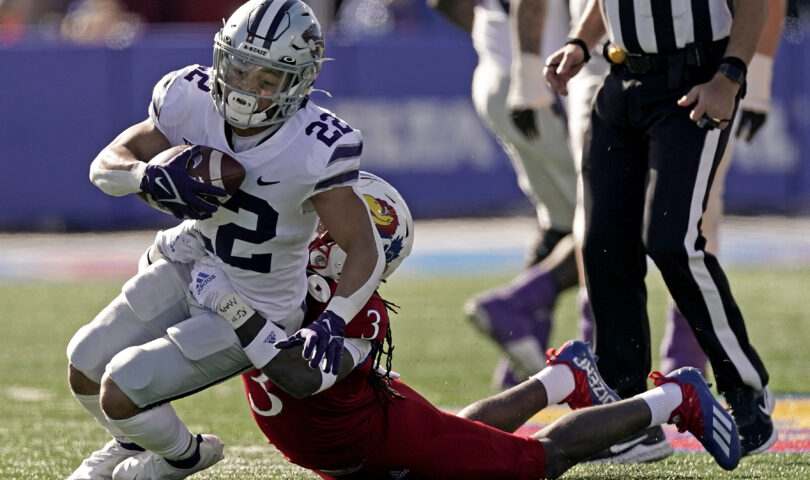MORGANTOWN — In a conference where offensive and defensive innovation are the norm within the Big 12, Kansas State was always the one team that stayed consistent in what they wanted to do — play disciplined and hard-nosed football.
That was a staple under Bill Snyder for decades and Chris Klieman took a similar approach when he first arrived at KSU in 2019. Simple, methodical offense and a basic 4-3 defense were what you got from the Wildcats.
That’s not the case anymore in Year 3 under Klieman.
“Normally, I would go back a year and say, ‘OK,’ but they’re totally different defensively,” WVU head coach Neal Brown said as the Mountaineers will face KSU at noon Saturday in Manhattan, Kan. “They’ve totally changed their schemes. I don’t know if there’s any carryover from the last few years.”
It’s an unusual situation for the Wildcats (6-3, 3-3 Big 12), completely overhauling their defense under the same defensive coordinator. Scottie Hazleton was the DC under Snyder in 2017 and ’18, and was retained by Klieman when he was hired.
Wanting to rejuvenate what was a lackluster defensive effort in 2020, KSU moved to a 3-3-5, but is multiple with how many down linemen it has.
The switch appears to be working — the Wildcats are third in the Big 12 in total defense behind Oklahoma State and Iowa State at 340 yards allowed per game.
Defensive end Felix Anudike-Uzomah is one of the premier defenders in the Big 12 with 10 sacks on the season, including six — SIX — against TCU on Oct. 30.
“It’s very easy to see as soon as you flip the film on that he demands everybody’s respect and attention in order for us to have success in this game, there is no question,” WVU offensive coordinator Gerad Parker said.
KSU’s methodical approach to offense is also changing, becoming more explosive and blending in more to what other teams are doing in the conference. The Wildcats have nine plays over 50 yards, which is second in the league behind Oklahoma.
Quarterback Skylar Thompson, who has dealt with injuries throughout his career, isn’t running as much as he used to, but is standing strong in the pocket and hitting deep passes to receivers Philip Brooks and Malik Knowles — each with over 340 yards receiving and two touchdowns.
“Why he’s not running as much, maybe he got beat up over the last two years,” WVU defensive coordinator Jordan Lesley said. “He has a big arm and is one of the better quarterbacks in our league at sitting back and diagnosing a defense. When you look at the ability they have with (running back) Deuce Vaughn and all their running backs, how they get them in a formation and situations, and then those receivers outside, he doesn’t have to run as much, because he can deliver the ball and diagnose. It’s probably a little combination of both.”
Vaughn, at 5-foot-6 and 173 pounds, is a difficult match-up for opposing linebackers, and KSU uses that to its advantage in the running and passing games. He is hard to find behind the offensive line, so the Wildcats can hide him well behind certain gaps in the running game.
In the passing game, Vaughn can slip out on screens and wheel routes, so when defenses are keying in on him underneath, they have gotten beaten over the top, which has led to KSU’s high number of explosive plays.
Vaughn has 866 yards and 12 touchdowns on the ground — 5.6 yards per carry — along with 37 catches for 411 yards and three touchdowns receiving.
“They do a really nice job of limiting your opportunities to do that, whether it’s moving the pocket with play actions of different forms or max protection, which people do to us a lot and Oklahoma State did that to us a lot and almost every play they throw the ball downfield,” Lesley said. “Some of the structure of their offense is how the quick game is built. They don’t give you a lot of those opportunities and their offensive line is as good of a unit playing collectively together and not making mistakes as anybody in our league. It’s a little bit of everything, which makes a good offense.”
TWEET @SeanManning_1




